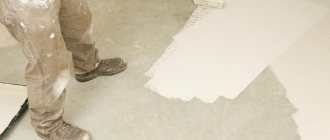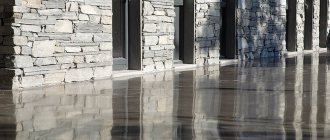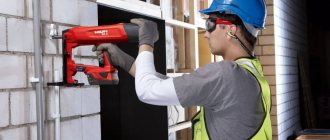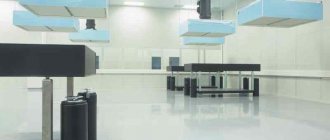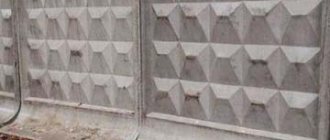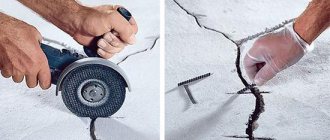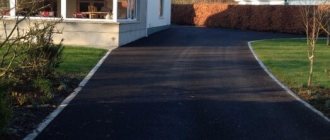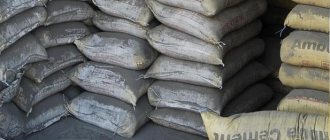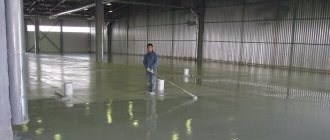Beton-House.com
Website about concrete: construction, characteristics, design. We combine the experience of professionals and private craftsmen in one place
Painted concrete floor
Concrete floors have been and still remain a popular option for foundation construction in both industrial and public buildings. They are also actively used in the construction of private buildings. For their subsequent finishing, various materials are used, including paint and enamel for concrete floors.
Let’s look at what types of products can be used to create a high-quality coating, as well as what the leading domestic and foreign products for concrete floors offer on the market.
- Novbytkhim
Painting concrete surfaces - what are the features?
Untreated concrete base is hardened cement, porous and coarse-grained. This texture quickly begins to crumble and become dusty even with minimal impact; when moisture gets in, the concrete breaks down even faster. Water washes out some components of the composition, and at low temperatures freezes in the pores, reducing the strength of the material.
To eliminate these problems, strengthening substances are introduced into the cement mixture, and then additionally stabilized using painting, which eliminates dust, smoothes out roughness, fills the loose structure and protects from moisture, and forms a resistant film that prevents the material from crumbling.
Concrete walls, ceilings, floors, foundations and sidewalks can be painted.
Note! It’s good if the enamel has good hiding power and one layer is enough to completely change the original color of the concrete.
Turnkey painting cost per m2
Dust removal - 0.2 mm.
- Materials and costs: 0303 -0.4 kg/m2.
- Price of materials price: 156 rub./m2.
- Material price from: 140 rub./m2
- Main types of work: sanding, priming 2 layers.
- Work prices: from 100 rubles/m2.
- Price of material + work: from 240 rub.
Painting with epoxy paints 1 - 0.4 mm
- Materials and costs: EP-0303-0.4 kg/m2; EP-2346-04 kg./m2.
- Price list of materials: 156+160=316 rub./m2.
- Material price from: 284 rub./m2.
- Main types of work: sanding, priming 2 layers, painting 2 layers.
- Work prices: from 250 RUR/m2.
- Price of materials + work: from 534 rubles.
Painting with epoxy paints 2 - 0.4 mm
- Materials and costs: EP-0302-0.25 kg/m2; EP-2346-04 kg./m2.
- Price list of materials: 123.75+160=283.75 rub./m2.
- Material price from: 254 rub./m2.
- Main types of work: sanding, priming 2 layers, painting 2 layers.
- Work prices: from 250 RUR/m2.
- Price of materials + work: from 504 rub.
Painting with polyurethane paints - 0.4 mm
- Materials and costs: PU-0310-04 kg./m2; PU-2356-04 kg./m2.
- Price of materials: 124+146=270 rub./m2.
- Material price from: 243 rub./m2.
- Main types of work: sanding, priming 2 layers, painting 2 layers.
- Work prices: from 250 RUR/m2.
- Price materials + work: from 493 rub.
The minimum cost per square meter with material is indicated. To calculate the cost of a self-leveling floor, the price per m2 of which depends on the area of pouring, please contact our manager by phone
Types of concrete paints that are suitable for interior and exterior work
Concrete paint is selected based on several criteria. The most important is where the work is carried out - outside or inside the premises. For outdoor work, it is important that the material is resistant to low temperatures and UV rays, moisture resistant, dries quickly and looks aesthetically pleasing.
Indoor paint must be safe for health and not contain highly toxic components. For both indoor and outdoor work, the paint should protect the concrete from moisture.
Basic requirements for paint, regardless of where it is used:
- good adhesion,
- vapor permeability,
- abrasion resistance,
- economical consumption.
Classification by composition and type of surface to be painted
To get the desired result, experts recommend paying great attention to choosing the right paint for concrete. There is a lot of different information on the Internet, but there is a standard gradation of materials according to composition and type of surface to be painted.
You can list the main materials by composition:
- Acrylic. These paints are popular not only for concrete surfaces. They contain special polymers and their derivatives, under the influence of which a dense, elastic, breathable film is obtained. Among the advantages of acrylic paints, it is worth noting wear resistance, economical consumption, low price, good hiding power, ease of application, durability of the coating, high drying speed and the ability to use in moderately damp rooms.
- Among the disadvantages, they note the need for careful preparation of the surface for painting, including preliminary priming.
- It is important not to confuse acrylic and alkyd enamels. Alkyd paints are oil paints. They form a hard film on the surface, whose performance properties are worse than those of acrylic compounds.
- Epoxy. They contain epoxy resin and hardener, which must be mixed with a construction mixer to obtain finished enamel. The result is that a waterproof, durable film hardens on the concrete base, which is resistant to any type of impact and retains its appearance for a long time. Therefore, it is often purchased for painting concrete floors. Depending on additional components, the film can be flexible or rigid.
- Among the disadvantages is the possibility of an error in proportions during preparation of the composition.
- Vinyl. These paints create a beautiful matte surface, dry quickly, cover well in one coat, are odorless, environmentally friendly and hypoallergenic. However, now they have almost been replaced by acrylic analogues, since the service life of vinyl coating is no more than 7 years, it is not moisture resistant enough and almost does not “breathe”, which means that concrete deteriorates faster.
- Polyurethane. This is an ideal paint for concrete floors. Particularly resistant to abrasion and mechanical stress. The only negative is the long drying time; complete drying takes up to two weeks.
- Rubber. The consistency is similar to mastic, which after drying resembles rubber. The coating is very durable, but at the same time elastic due to the acrylate latex in the composition. One of the advantages is frost resistance: you can work with paint outside even at -50 degrees. Latex paints are often used on playgrounds and sports fields.
- Water-based. The main component of paint is water, so such materials are non-toxic, easy to wash off, do not smell and are available in a wide palette of shades.
- Silicone emulsion. One of the best offers in terms of its characteristics on the market. It can be used within two days after the concrete has hardened. The enamel forms a completely waterproof, but at the same time “breathable” coating, has high adhesion, is elastic, and wear-resistant. The only drawback is the very high price.
Depending on the surface that is supposed to be painted, there are:
- Concrete enamel for facade. Concrete walls of buildings must be protected from aggressive environmental influences. What is important here is the high penetrating ability of the composition and economical consumption, as well as service life, since repainting building facades is not a very fast and labor-intensive process.
- Foundation paints. Acrylic, polyurethane, epoxy, and silicone compounds are suitable here. When choosing, you need to be guided by the characteristics of concrete and environmental factors. For example, for cold regions, paints based on epoxy resins are used.
- Floor paints. Paints for concrete floors must meet several criteria - resistance to abrasion and mechanical damage, as well as moisture resistance. Polyurethane, acrylic, rubber, epoxy enamels have these properties.
- Materials for painting paving slabs, concrete garden paths and blind areas. The same requirements apply to these paints as to floor paints. But additional attention is paid to protection from precipitation, so acrylic compounds are not suitable here.
Manufacturers
The modern construction market offers a huge number of varieties of paints and varnishes. Among them there are both foreign and domestic brands, and the products have a wide price range, so you can easily select the necessary products.
According to application, all paints are divided into two types:
- Professional – intended for use in industrial premises. They are characterized by high performance indicators. Their only drawback is their high price.
- Household ones - the cost is much cheaper than professional ones, but at the same time they have good characteristics. Therefore, they are suitable for use in rooms with light loads.
Popular manufacturers:
- Zebra;
- Deco;
- Dufa;
- Emalux;
- Polyfarb;
- Tikurilla.
When choosing, you should carefully study the scope of application, since the materials differ from each other. And also strictly follow the instructions for use.
Average score of ratings is more than 0
Share link
Comments There are no comments yet, but you could be the first...
How to choose the right paint
To choose a good paint, it is recommended to pay attention to several points.
First you need to assess the intensity of use of the concrete base. For example, to paint walls you will need less wear-resistant enamel than to paint a concrete floor in a garage.
It is important where the painting will be done. For interior work, non-toxic, odorless enamel is required. For outdoor work, resistance to precipitation, UV rays and external damage is important.
Many manufacturers produce universal paints, and before choosing one, you need to carefully study the composition information on the label and recommendations for use.
There is a complete list of requirements for enamels for concrete, however, there is still not a single brand that could combine them all:
- waterproofing properties;
- resistance to low and high temperatures;
- fire resistance;
- health safety;
- neutral smell;
- resistance to physical and mechanical damage;
- ease of care.
Which wear-resistant material should I use for a concrete floor to avoid dust?
When deciding what to paint a concrete floor with, craftsmen recommend paying attention to deep penetration paints. The porous structure of concrete is very fragile and when the partitions between the pores break, the surface begins to gather dust. To avoid this, you need to fill the empty pores with paint, which will give strength to the material and increase its wear resistance.
There are two methods of painting concrete - deep and surface.
With deep coloring, the enamel penetrates deep into the porous structure of concrete, giving it a lasting color and improving the strength and durability of the material. This technology is quite expensive, so surface painting is often used.
Epoxy, polyurethane or rubber are commonly used as wear-resistant paints for concrete floors. Polyurethane can be painted in industrial premises due to its high resistance to mechanical damage.
Note! In order for the paint to adhere well, you must first prime the concrete screed. The use of deep penetration primer and paint will ensure optimal durability of the coating.
Why paint concrete
Polymerization of the composition will protect the porous surface of concrete, which over time crumbles and splits, forming cement dust. The screed is usually protected with something, especially with a heated floor system. Self-leveling polymer flooring in residential areas additionally levels the surface.
Painting is a budget alternative to expensive coatings such as quartz vinyl, laminate and expensive tiles. In auxiliary premises there is no need to “go broke” on repairs. It is better to think about how to paint the cement floor of an apartment:
- In the pantry;
- On the loggia (balcony);
- In the bathroom (shower) or toilet;
- On the aisles and in the corridors.
The ease of painting and affordable prices for compounds that additionally fasten concrete are the main reasons why you should refuse expensive floor repairs where you can carry out the whole range of restoration measures for the floor yourself.
Sometimes you have to make “temporary” repairs in order to move into an unfinished house or apartment that is at the stage of major renovation for the winter.
Unfortunately, we have not yet come up with a unified composition that meets all operational requirements. Today, paint and varnish materials (paint and varnish materials) are selected individually, taking into account the preferences of the home owner and the possible load. A cement screed painted with an inexpensive acrylic composition will help solve the issue of quickly preparing the floor for use.
Polymerization of the composition will protect the porous surface of concrete, which over time crumbles and splits, forming cement dust.
Preparing concrete walls for painting
The process of preparing concrete walls for painting consists of several stages.
- Surface cleaning, which may include: removal of old oil paint, removal of mold and dirt. If the concrete is fresh, cement laitance forms on its surface, which must be sanded after the material has dried.
- Removing dust from the surface (you can use a vacuum cleaner).
- If there are cracks and potholes, they are filled with plaster, putty or polyurethane foam.
- After the mixture has dried, the surface is sanded manually or with a special grinding machine and then primed.
Now you can proceed to painting, having previously carried out tinting. To do this, use a white base paint and add pigment.
Application technology
Before proceeding to the direct application of the dye to the surface of the floors, several preparatory steps need to be carried out. They will be discussed in more detail in the following chapters.
Before proceeding to the direct application of the dye to the surface of the floors, several preparatory steps need to be carried out.
Preparing the concrete surface
The preparation of the concrete base itself will determine how long and well the paint will last. Moreover, the actions differ on concrete structures that have just been built from those that are already standing for a long period of time.
A fresh screed can be painted five days after creation. At this time, the concrete hardens well enough and has the necessary moisture content for applying paint to it.
This process can be performed using a trowel or a stiff brush. All dust should be vacuumed up after this.
If painting is carried out on an old concrete surface, then, on the contrary, it must be thoroughly dried. Otherwise the epoxy will start to peel off. The moisture content of the base is determined using a special device. If it is absent, you can glue a film to the surface, after 24 hours they look to see if it is covered with moisture and if it is damp to the touch. If the film is dry, then you can proceed to painting; if not, you should wait until the floors are completely dry.
Next, an inspection is carried out for the presence of flaws. Those places where there are large cracks are expanded to 5 millimeters; such defects will be covered with epoxy putty. The surface is also cleaned and vacuumed.
The surface is leveled, all existing defects are removed from it.
Precautionary measures
Two-component compositions, which are the most popular, must be mixed for painting. At this time, they can release substances harmful to human health. Therefore, work must be carried out in protective clothing, special glasses and rubber gloves are worn, and a respirator is also required.
The room must be provided with good ventilation. Do not use utensils that are used for food purposes. If the mixture gets on the skin, it is immediately cleaned with denatured alcohol or white vinegar; it is not allowed to harden on the skin.
The room must be provided with good ventilation.
Flow calculation
The paint consumption for self-leveling floors is indicated on the packaging and is calculated per 1 square meter. Accordingly, to find out how much material is needed, you need to calculate the area, and also decide how many layers will be applied to the floor.
When calculating the area, all recesses and recesses are taken into account; if the room is complex in structure, then it is divided into several zones, and then their areas are summed up. The average consumption, which is usually equal to 1 mm per 1.5 kg (the exact figure is indicated by the manufacturer on the packaging), is multiplied by the layer thickness and the area of the room.
When calculating the area, all recesses and recesses are taken into account.
Can I use a spray gun?
A spray gun simplifies many types of painting work and saves paint. But in the case of working with epoxy enamel, its use is impractical. After all, enamel is distinguished by its rapid rate of hardening, so it can simply ruin the device itself.
Therefore, it is better to paint with a roller or brush. After painting, you can immediately throw them away; they will become unusable.
It is better to paint with a roller or brush.

